
by Ace Concierge | Virtual Assistant | May 1, 2024 | Business Transformation, Small Business
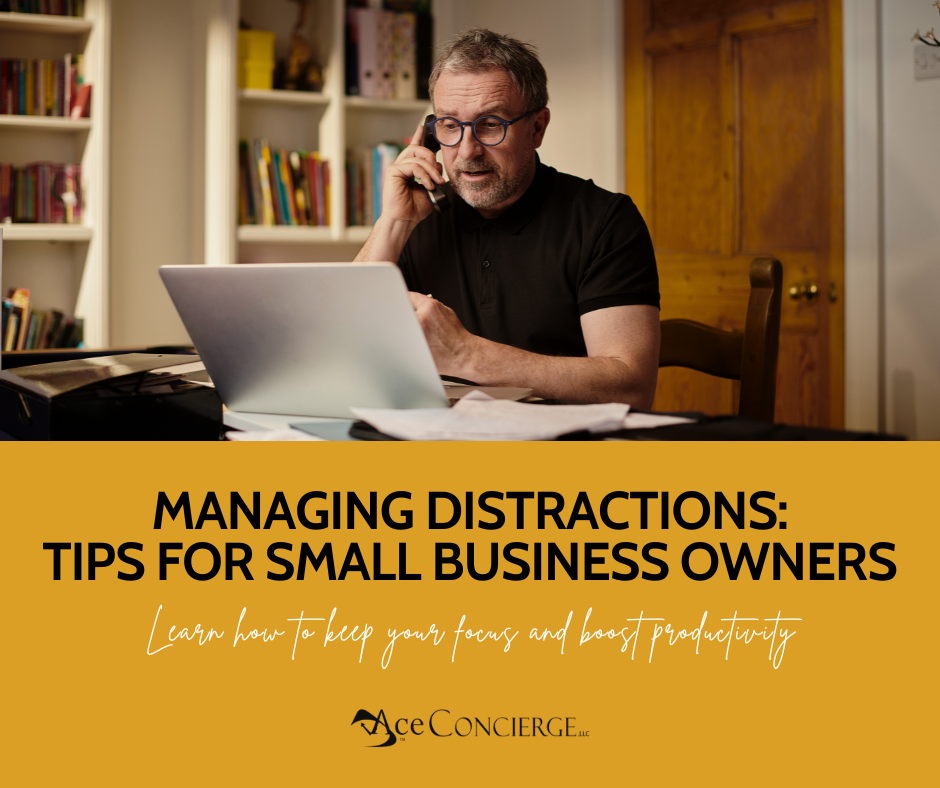
Small business owners deal with a lot daily—from managing customer inquiries and employee issues to handling supplier calls and operational tasks. It’s hard to stay on track and get things done when so many distractions exist. Feeling frazzled and stressed out is common when your plans are constantly disrupted. Many business owners feel like they’re always being pulled in multiple directions.
When they think they’ve carved out a few hours to work on a strategic initiative, an urgent order comes in, or an employee needs immediate attention. This cycle of bouncing from one fire to the next can leave small business owners wondering what they accomplished by the end of the day. The relentless nature of running a small business makes it incredibly challenging to protect your time and stay on track with essential priorities.
But with the right strategies and mindset, you can tame the chaos and reclaim your productivity.
Identify Your Productivity Pitfalls
The first step in mastering distractions and interruptions is understanding where they originated. Take a close look at your daily routine and identify the biggest culprits:
- Constant email and messaging notifications
- Unplanned drop-in visits from employees or customers
- Unexpected phone calls that derail your focus
- Multitasking between various projects and tasks
Small business owners often pride themselves on managing multiple tasks simultaneously. However, research shows that constant switching between activities can make us less efficient, as we spend more time trying to remember where we left off than actually getting work done. Once you’ve pinpointed your primary productivity pitfalls, you can start to implement targeted solutions.
Establish Boundaries and Protect Your Time
One of the most effective ways to minimize distractions and interruptions is to set clear boundaries around your time and attention. This might mean:
- Designating specific “focus hours” each day when you shut off notifications and avoid taking calls
- Implementing a system for screening and prioritizing incoming requests, whether it’s from customers, employees, or vendors
- Politely but firmly set expectations with your team about when you’re available and when you need uninterrupted time to work.
Some small business owners report feeling guilty about closing their doors or turning off their phones, worried they’re letting their team or customers down. But by protecting your focus time, you can be more present and productive when you are available—a true win-win.
Leverage Technology to Your Advantage
While technology can be a distraction source, it can also be a powerful tool for boosting productivity. Explore apps and software that can help you:
- Automate repetitive tasks and workflows
- Streamline communication and collaboration with your team
- Block distracting websites and apps during designated work periods
- Schedule and batch your most time-consuming activities
Many small business owners waste significant time toggling between different tabs and apps, trying to keep track of everything. Discovering a centralized project management tool or other productivity-enhancing technology can be a game-changer for focus and efficiency. I personally love Redbooth.
Foster a Focused Mindset
Mastering distractions and interruptions is as much a mental game as a practical one. Cultivate a mindset that prioritizes focus, discipline, and intentionality:
- Practice mindfulness and meditation to improve your ability to stay present
- Experiment with the Pomodoro Technique or other time-management strategies
- Celebrate your small wins and recognize the progress you’re making
Small business owners often find themselves in a never-ending game of catch-up. However, pausing and recognizing your achievements is essential, even on the busiest days. This can provide the motivation needed to keep moving forward.
By implementing practical strategies and maintaining a focused mindset, you can regain control of your time and become a force of productivity. Always remember, owning a small business is a marathon, not a sprint.
With the right tools and techniques, you’ll reach the finish line feeling energized and accomplished.
The successful warrior is the average man, with laser-like focus. Bruce Lee

by Ace Concierge | Virtual Assistant | Apr 24, 2024 | Business Transformation, Leadership

In today’s fast-paced, digitally driven world, it’s easy to feel overwhelmed by the constant barrage of information, notifications, and demands on our time. I’ve seen firsthand how a lack of focus and the inability to engage in deep work can hinder our ability to achieve our goals and reach our full potential. However, by embracing the power of focus and deep work, we can unlock a world of possibilities and transform our daily lives.
The Epidemic of Distraction
Recent studies have shown that the average person’s attention span has decreased significantly. The average person can now focus for 8 seconds, down from 12 seconds in 2000. This is due mainly to the proliferation of digital devices and the constant stream of information and stimuli we’re exposed to daily.
“The ability to focus is a superpower.” – Chris Bailey, author of “The Productivity Project”
This epidemic of distraction has far-reaching consequences, not only for our productivity but also for our overall well-being. Constant multitasking and the inability to focus can lead to increased stress, decreased cognitive function, and even a decline in mental health. This is where the concept of deep work becomes crucial.
In one year, the average knowledge worker allocates 103 hours to unnecessary meetings, 209 hours to duplicated work, and 352 hours to work-related discussions (Asana).
The Power of Mindfulness
One critical strategy for overcoming distraction challenges is the practice of mindfulness. Mindfulness is the art of being present in the moment, fully engaging with the task at hand, and tuning out the noise of the external world.
“Mindfulness is the ability to be fully present and aware in the current moment.” – Jon Kabat-Zinn, founder of Mindfulness-Based Stress Reduction
By cultivating a mindful mindset, we can train our brains to stay focused and attentive, even in the face of distractions. This boosts our productivity and enhances our overall sense of well-being and satisfaction. In addition to mindfulness, the concept of deep work, as popularized by Cal Newport, is a powerful tool for enhancing our focus and productivity. Deep work refers to the ability to engage in focused, uninterrupted work for extended periods without the distractions of email, social media, or other digital noise. By setting aside dedicated time each seek, we can significantly increase our output and the quality of our work.
“Shallow work is what we do when we’re distracted. Deep work is what we do when we’re focused.” – Cal Newport
Optimizing Your Deep Work Sessions
Environment Optimization
Creating a dedicated workspace that’s free from distractions is key. Set up a quiet corner in your home or office with minimal visual and auditory interruptions. Use noise-cancelling headphones, ambient music, or white noise to block out external disturbances and cultivate a productive atmosphere.
Time Blocking
Implement a structured schedule with specific blocks of time dedicated solely to deep work tasks. By allocating focused time slots for intensive work, you can prioritize essential projects and minimize multitasking.
Digital Detox
Minimize digital distractions by turning off notifications on your electronic devices during deep work sessions. Utilize apps or browser extensions that block access to distracting websites and social media platforms.
Break Strategies
Incorporate short breaks between deep work intervals to prevent mental fatigue and maintain productivity. Use these breaks to stretch, hydrate, or engage in light physical activity to rejuvenate your focus.
Goal Setting
Define clear objectives and goals for each deep work session to maintain direction and motivation. Setting specific targets can help you stay on track and measure progress throughout your focused work periods.
Accountability Partners
Consider partnering with a colleague or friend who shares similar deep work goals. Holding each other accountable and providing mutual support can boost motivation and commitment to sustained focus.
Reflection and Iteration
Reflect on your deep work practices regularly to identify areas for improvement and adjustment. Experiment with different techniques, routines, and strategies to optimize your workflow and enhance the quality of your deep work sessions.
Overcoming Obstacles and Embracing the Journey
It takes real effort to break free from those ingrained habits and temptations that pull us in many different directions. But you can overcome those obstacles with patience, self-compassion, and a willingness to experiment.
Trust me, the payoff of cultivating that focused mindset is enormous – you’ll unlock a whole new level of productivity and achievement in your personal and professional life.
It’s all about finding and sticking with what works best for you. Sure, there may be ups and downs, but hang in there, and you’ll be reaping the rewards in no time.

by Ace Concierge | Virtual Assistant | Apr 17, 2024 | Work Life Balance

Work-life balance is a topic discussed to death, but for good reason.
Finding that elusive equilibrium between our professional and personal lives can feel impossible in our fast-paced, always-on world. I get it – I’ve been there.
There have been so many times when I’ve felt completely overwhelmed, like drowning in a sea of work deadlines, household chores, and family obligations. It’s enough to make anyone want to throw in the towel. However, the truth is that balance is not something you stumble upon by chance. It’s something you have to create and maintain through intentional effort and boundary-setting actively.
Be steady and well-ordered in your life so that you can be fierce and original in your work. Gustave Flaubert
The Importance of Work-Life Balance
In a recent survey, over half of workers reported feeling burned out, with the top contributing factors being an unmanageable workload and a lack of work-life balance. And it’s not just our mental health that suffers – poor work-life balance has also been linked to physical health issues like heart disease, obesity, and insomnia. Conversely, employees with a healthy work-life balance report higher job satisfaction, increased productivity, and better overall well-being. The bottom line is this: creating and maintaining a work-life balance isn’t just a nice-to-have – it’s essential for our professional and personal success. And it’s up to us as individuals to take the reins and make it happen.
Steps to Create Intentional Balance
So, how do we go about creating this elusive state of balance? It starts with being intentional and proactive. Here are some critical steps that have worked for me:
- Set Boundaries: One of the biggest challenges to work-life balance is the digital age’s constant connectivity. It’s all too easy for work to bleed into our time. That’s why setting clear boundaries around when you’re “on” and “off” the clock is crucial. This could mean turning off notifications after a certain time, avoiding checking email in the evenings, or even scheduling “no meeting” blocks in your calendar.
- Prioritize and Delegate: With endless to-do lists and competing priorities, it’s easy to feel overwhelmed. That’s why it’s important to get intentional about how you’re spending your time. Take a step back and identify your most important tasks and responsibilities. Then, look for opportunities to delegate or deprioritize less essential items. Don’t be afraid to say no to requests that don’t align with your priorities.
- Create a Schedule: A clear, structured schedule can be a game-changer regarding work-life balance. Block out time for work, exercise, family time, hobbies, and self-care. And be sure to build buffer time between activities to avoid feeling rushed. Experiment to find a rhythm that works for you.
- Unplug and Recharge: In our always-on world, making time to unplug and recharge is crucial. Whether it’s a weekly tech-free day, a monthly digital detox, or an annual vacation, fully permitting yourself to disconnect from work can do wonders for your mental and physical well-being.
- Cultivate Supportive Relationships: The people in our lives can significantly impact our work-life balance. Surround yourself with colleagues, friends, and family who understand the importance of balance and can help you maintain it. Don’t be afraid to lean on your support system when needed.
We respond to the environments we’re in. If you get the environment right, you get the right behavior. Simon Sinek
Putting it All Together
Creating and maintaining a work-life balance is an ongoing process, not a one-time fix. It requires constant self-awareness, boundary-setting, and course correction. But the payoff is well worth it. When we achieve that coveted equilibrium, we experience increased productivity, better physical and mental health, and greater fulfillment. And that’s a win-win for both our professional and personal lives.
So, the next time you feel overwhelmed or out of balance, take a step back and remember that balance is not something you find. It’s something you create. With intention, discipline, and some trial and error, you can craft a harmonious and sustainable life.
What are your tips and strategies for balance?
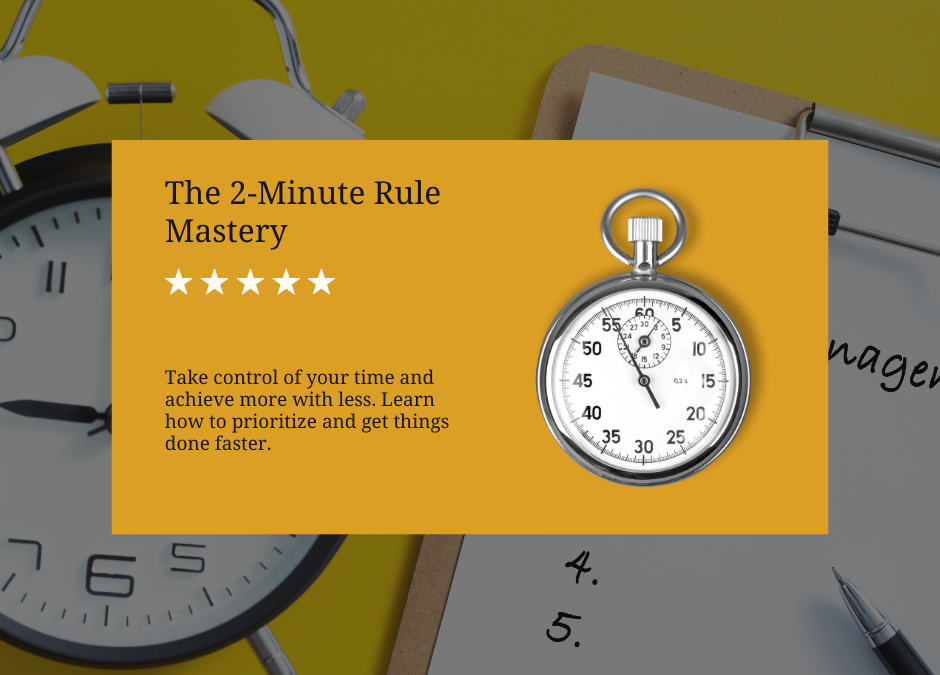
by Ace Concierge | Virtual Assistant | Apr 10, 2024 | Business Transformation, Productivity, Small Business
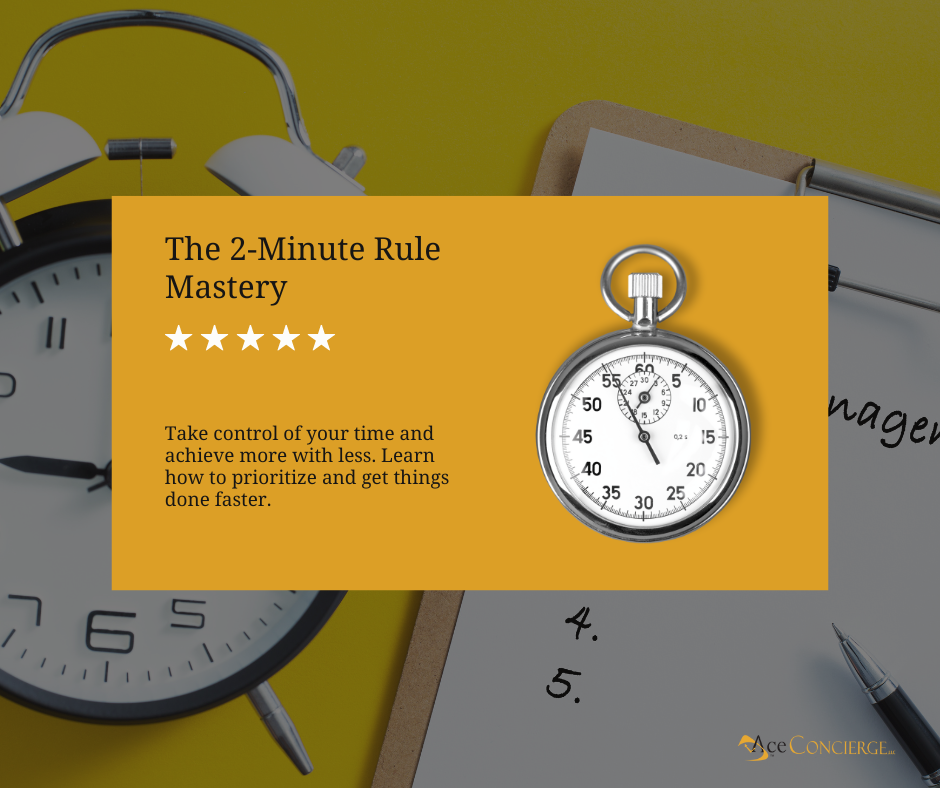
Hey, productivity masters! Today, I’d like to discuss a practical tool that significantly impacted my daily routine—the 2-Minute Rule. If you’ve ever felt overwhelmed by an ever-growing to-do list, this approach might be the solution you’re looking for.
It is quick, effective, and efficient. Let’s go!!
The Struggle of Overwhelming To-Do Lists
We’ve all been there. You sit down at your desk, determined to conquer the day, armed with a list of tasks that seems to grow exponentially as the hours tick by. It’s like playing a never-ending game of whack-a-mole, except the moles are your responsibilities, and they keep coming back. It’s just not doable.
I believed in prioritizing big tasks for maximum productivity. However, complex, high-level tasks require scheduled ‘deep focus.’ Allocate dedicated time for those larger projects and employ the 2-Minute Rule for the rest.
Enter the 2-Minute Rule
Cue the entrance of the 2-Minute Rule, my knight in shining armor, in the battle against an unruly to-do list. The concept is simple yet profound – if a task takes less than 2 minutes, do it immediately. No delays, no procrastination. Set a timer if you must, but get it done.
This strategy works wonders because, let’s face it, the small tasks are like weeds. Ignore them for too long, and suddenly your garden is overrun. Addressing tasks that take less than 2 minutes immediately prevents the accumulation of tiny chores that collectively can be a time-consuming nightmare.
Identifying the 2-Minute Tasks
You might wonder how to spot these quick 2-minute tasks. It’s simpler than you think. Consider them the readily manageable items in your productivity list—the emails needing a swift response, the postponed phone calls, or the documents needing minor edits.
If a task requires minimal effort and can be completed quickly, it falls into the 2-minute category. Remember that we’re not discussing monumental challenges; instead, we’re focusing on those doable tasks that, when addressed collectively, significantly enhance your daily efficiency.
Setting the Timer and Taking Control
One of the beauties of the 2-Minute Rule is its simplicity. All you need is a timer – your phone, a kitchen timer, or even an old-school hourglass. When you come across a task that fits the criteria, set the timer for 2 minutes and dive in. You’ll be amazed at how much you can accomplish in such a short time.
The timer serves as your accountability partner, urging you to stay focused and avoid getting lost in the black hole of small tasks. It transforms the mundane into a challenge, and who doesn’t love a good challenge, especially when it leads to increased productivity?
Breaking the Procrastination Cycle
Let’s be real; we’re all guilty of procrastination. There’s something strangely satisfying about pushing tasks to the bottom of the pile, convincing ourselves we’ll get to them eventually. But here’s the kicker – eventually rarely comes.
The 2-Minute Rule is a procrastination buster. It breaks the cycle by making tasks so manageable that delaying them becomes absurd. It’s like telling yourself, “Why put it off for later? What can I finish now and be done with it?”
My Transformation
I can’t stress enough how this simple rule transformed my daily life. The feeling of accomplishment that comes from quickly knocking off tasks is addictive. Instead of feeling overwhelmed by the never-ending to-do list, I now see it as a series of small victories waiting to be claimed.
The big tasks still loom on the horizon, but they no longer cast a shadow over my entire day. By mastering the 2-Minute Rule, I’ve regained control of my time. I no longer dread the small tasks, and my productivity graph has shot through the roof.
So, there you have it – the secret weapon that helped me regain control of my time and boost my overall productivity. The 2-Minute Rule is not just a strategy; it’s a mindset shift. It’s about acknowledging the power of small actions and understanding that they add to significant results.
Try it; set a timer, tackle those quick tasks, and witness the magic unfold. The 2-Minute Rule is not just a time management technique; it’s a game-changer that puts you back in the driver’s seat of your day.
Say goodbye to the overwhelm and hello to ultimate time control! ⏰
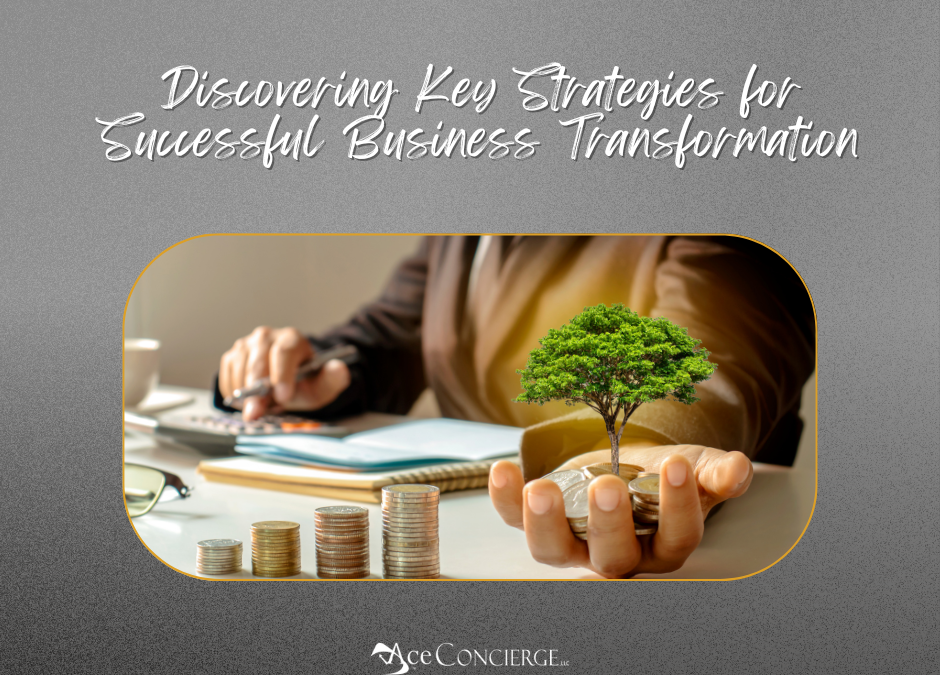
by Ace Concierge | Virtual Assistant | Apr 3, 2024 | Business Transformation, Leadership
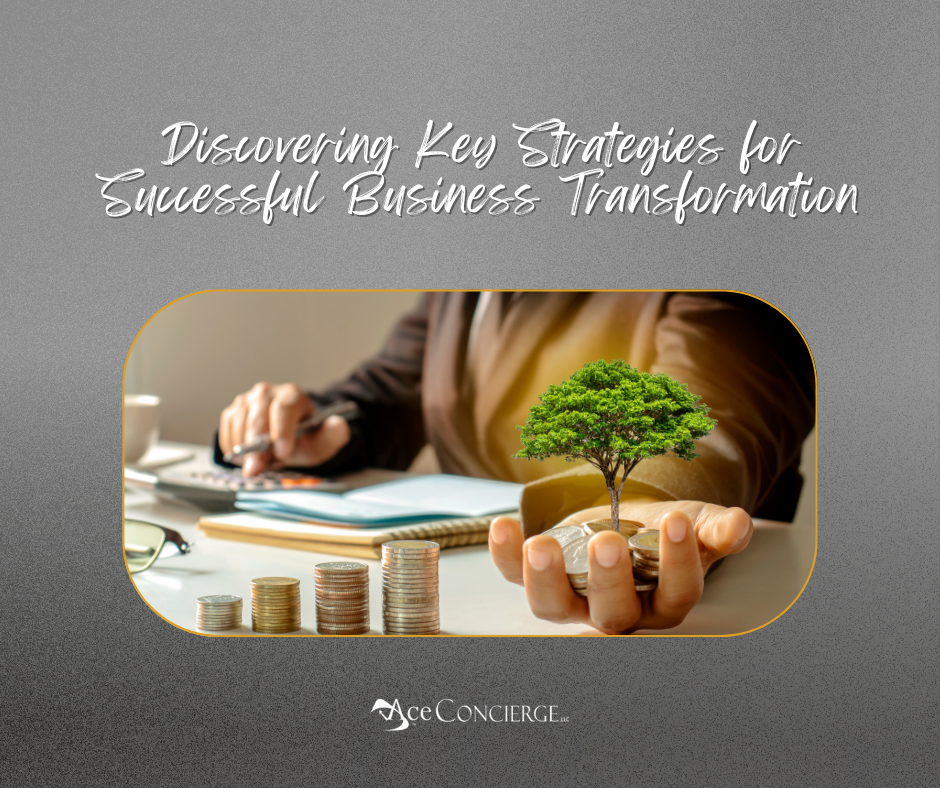
In the wild business world, there’s a golden rule: “If you keep spinning in circles, don’t expect to land on Jupiter!”
Whether starting a new venture or jazzing up an old one, the significance of building or transforming a business from the ground up cannot be overstated. This process is akin to laying a strong, sturdy, and functional foundation essential for long-term success and sustainability.
It all begins with a vision, a spark that ignites the flame of innovation. Embrace the thrill of transformation as you breathe new life into your business. Every tweak, every adjustment, every bold leap forward is a step towards greatness.
“If you are not ready to change yourself, forget about changing your team and your organization.” Dr. Patrick Liew, executive chairman at GEX Ventures.
Embracing Change for Growth
Starting or transforming a business means being open to change and shaking things up. It’s all about embracing innovation, adapting, and always getting better. It’s time to break out of your comfort zone!
The Humbling Experience of Starting Anew
This journey can be a truly humbling experience. It requires us to let go of any preconceived notions, unproductive practices, or outdated strategies, but it is absolutely necessary to mend any cracks that may have developed over time. By rebuilding a business from scratch, we can eliminate weaknesses and establish a more solid framework for future growth.
Avoiding Band-Aid Solutions
Trying to solve business challenges with quick fixes is like putting a band-aid on a severe wound. Fundamental transformation needs a thorough strategy that tackles root problems and brings lasting change. Business owners can break free from ineffective cycles by avoiding hasty solutions, concentrating on fundamental enhancements, and creating a sustainable path to success.
Getting to the Root Cause
When it comes to business transformation, applying root cause analysis emphasizes the similarity between personal growth and corporate development. Just as individuals focus on improving their core habits for overall well-being, businesses must identify and resolve foundational challenges to unlock their full potential. Ignoring and failing to correct harmful practices or mindsets can undermine positive initiatives.
The Power of Strong Foundations
A well-established organization is better able to navigate problems and capitalize on opportunities. A solid infrastructure, including efficient operating procedures, strong leadership, and a clear strategic direction, provides the foundation for long-term success.
Embracing Innovation and Adaptation
Innovation and adaptability are essential for success and present a chance to incorporate these traits into the organization’s DNA. Businesses may stay ahead of industry trends and consumer preferences by fostering a culture that celebrates creativity, welcomes change, and always strives for the better.
Transformation can be exciting, but it’s easy to hit some speed bumps along the way. One of the biggest mistakes I see companies make is rushing the process, trying to get results fast without taking the time to get the fundamentals right – things like clearly defining roles, goals, and expectations. This can lead to confusion and disengagement among employees, a recipe for a bumpy transformation journey.
Transformation Pitfalls:
- Rushing the Process: There is a tendency to want quick results, but going too fast can lead to overlooking essential parts of the transformation process, resulting in more expense and delays down the line.
- Lack of Clear Roles, Goals, and Expectations: Failing to articulate clear roles, goals, and expectations can lead to misunderstandings and a lack of engagement among employees.
- Inadequate Change Management: Failing to communicate the need for change, lacking a clear vision of the future, and not equipping employees to adapt are common mistakes that impede the transformation process.
- Ignoring Data and Technology Intersections: Neglecting the interplay between data, technology, and processes can lead to inefficiencies and uninformed decision-making.
- Underestimating Culture Change: Introducing digital transformation without adequately addressing cultural shifts and failing to engage employees in the process can impede the success of the transformation.
- Not Prioritizing Business Benefits: Failing to identify and quantify business benefits or not correctly defining the business motivation and vision can lead to a lack of direction and unsuccessful outcomes.
- Trying to Do It All Alone: Many small business owners make the mistake of doing everything themselves, leading to oversights and inefficiencies. Seeking outside expertise and support can be beneficial.
“By understanding and managing a small number of common root causes and how these forces interact dynamically, you can prevent trouble in the first place or move effectively to rescue the project once trouble strikes.” PricewaterhouseCoopers
In closing, whether you’re starting a new business or breathing new life into an existing one, the significance of building or transforming from the ground up cannot be underestimated. By adopting the right mindset and implementing strategic approaches, you can skillfully navigate the landscape of transformation and unlock your business’s full potential.










